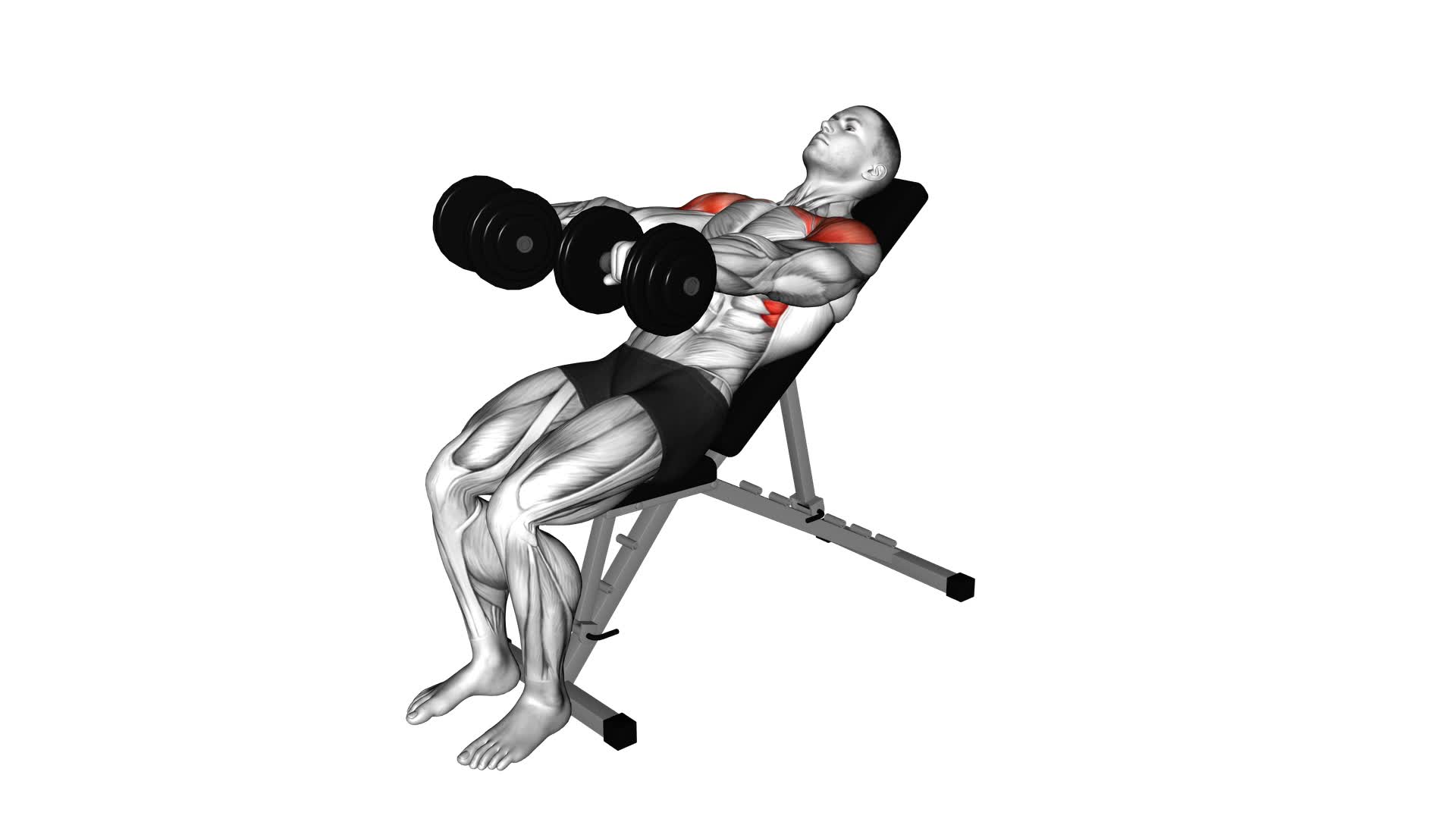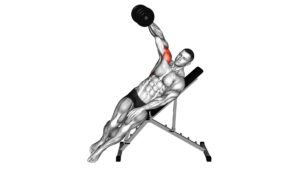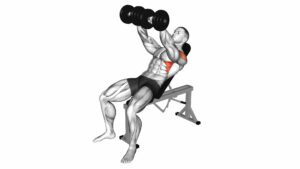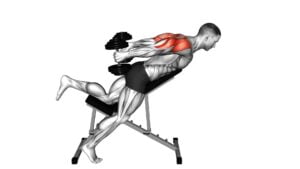Dumbbell Incline Raise – Video Exercise Guide & Tips

Looking to tone your shoulders and build strength? Look no further than the dumbbell incline raise.
Watch This Exercise Video
This exercise targets your deltoids and helps improve upper body stability.
In this video exercise guide, we'll show you the proper form and technique to get the most out of this move. We'll also cover variations and common mistakes to avoid.
Get ready to maximize your shoulder growth with this effective workout. Let's dive in!
Key Takeaways
- The dumbbell incline raise targets deltoids and improves upper body stability.
- It activates multiple muscles in the upper body, with a focus on the anterior and lateral deltoids.
- The exercise allows for a greater range of motion, leading to a deeper stretch and contraction.
- Compared to other shoulder exercises, the dumbbell incline raise places less stress on the rotator cuff muscles.
Benefits of the Dumbbell Incline Raise
To maximize your upper body strength and sculpt your shoulders, the dumbbell incline raise provides an effective exercise option. This exercise activates multiple muscles in your upper body, making it a great choice for overall shoulder development. The primary muscles targeted include the anterior and lateral deltoids, which are crucial for shoulder stability. By performing the dumbbell incline raise, you can strengthen these muscles and improve your shoulder stability, reducing the risk of injuries.
The incline position also increases the range of motion, allowing for a deeper stretch and contraction of the targeted muscles. This increased range of motion helps to improve flexibility and mobility in your shoulders. Additionally, the incline angle places less stress on the rotator cuff muscles compared to other shoulder exercises, making it a safer option for those with shoulder issues or injuries.
To perform the dumbbell incline raise, start by sitting on an incline bench with a dumbbell in each hand. With your arms fully extended and palms facing down, raise the dumbbells to shoulder height while keeping a slight bend in your elbows. Slowly lower the dumbbells back down to the starting position and repeat for the desired number of reps. Remember to engage your core and maintain proper form throughout the exercise.
Incorporating the dumbbell incline raise into your upper body workout routine will help you build upper body strength, sculpt your shoulders, and improve shoulder stability.
Proper Form and Technique
To ensure proper form and technique during the dumbbell incline raise, focus on maintaining good posture and control throughout the exercise. Start by sitting on an incline bench with your back firmly supported and your feet flat on the floor.
Hold a dumbbell in each hand, arms fully extended down and palms facing inwards. As you lift the dumbbells, keep your core engaged and your shoulders back and down. Avoid using momentum or swinging your arms to lift the weights. Instead, use controlled movements to raise the dumbbells up to shoulder height, making sure to keep your elbows slightly bent.
Pause for a second at the top and then slowly lower the weights back down to the starting position. This exercise primarily targets the front and side deltoids, but also engages the traps and upper chest muscles.
Remember, proper execution is key to maximizing the benefits of the dumbbell incline raise. Common errors to avoid include using too much weight, arching your back, or allowing your shoulders to shrug up towards your ears.
Variations of the Dumbbell Incline Raise
Try incorporating different variations of the dumbbell incline raise to target your shoulder muscles from different angles and intensify your workouts. Here are four alternative dumbbell exercises that you can try:
- Dumbbell Front Raise: Stand with your feet shoulder-width apart and hold a dumbbell in each hand, palms facing your body. Keeping your arms straight, raise the dumbbells in front of you until they're parallel to the ground. Slowly lower them back down and repeat.
- Dumbbell Lateral Raise: Stand with your feet shoulder-width apart and hold a dumbbell in each hand, palms facing your body. Keeping your arms straight, raise the dumbbells out to the sides until they're parallel to the ground. Slowly lower them back down and repeat.
- Dumbbell Bent-Over Raise: Bend your knees slightly and lean forward at the waist. Hold a dumbbell in each hand, palms facing your body. Keeping your arms straight, raise the dumbbells out to the sides until they're parallel to the ground. Slowly lower them back down and repeat.
- Dumbbell Arnold Press: Sit on an incline bench with a dumbbell in each hand. Start with your palms facing your body and your elbows bent. Press the dumbbells overhead, rotating your palms to face forward at the top of the movement. Slowly lower them back down and repeat.
Common Mistakes to Avoid
One common mistake to avoid when performing the dumbbell incline raise is allowing your back to arch excessively. This is a common mistake that many people make, especially when they're trying to lift heavier weights. When your back arches too much, it puts unnecessary strain on your lower back and can lead to injury.
To avoid this mistake, focus on maintaining a neutral spine throughout the exercise. Keep your core engaged and your back flat against the bench.
Another common mistake is using momentum to lift the dumbbells instead of relying on your muscles. This can happen when you swing your arms or use your back to lift the weights. To avoid this, focus on using a slow and controlled movement, keeping your elbows slightly bent and your shoulders relaxed.
Lastly, it's important to use the proper technique when performing the dumbbell incline raise. This includes starting with the dumbbells at your sides, raising them up to shoulder height, and then lowering them back down in a controlled manner. Avoid swinging the weights or using your body to lift the dumbbells.
Tips for Maximizing Shoulder Growth
If you want to maximize shoulder growth, continue focusing on proper form and technique while performing the dumbbell incline raise. This exercise is one of the best exercises for shoulder development and should be a staple in your shoulder workout routine.
Here are some tips to help you maximize your shoulder growth:
- Use a controlled and slow tempo: Slow down the movement and focus on the contraction of your shoulder muscles. This will ensure that you're effectively targeting the shoulders and not relying on momentum.
- Squeeze at the top of the movement: At the top of the movement, when your arms are parallel to the ground, squeeze your shoulder muscles and hold for a second or two. This will further engage the muscles and promote growth.
- Focus on the mind-muscle connection: Visualize your shoulder muscles working and concentrate on feeling the tension in the targeted areas. This will help you engage the right muscles and optimize your shoulder growth.
- Gradually increase the weight: As you get stronger, gradually increase the weight you're using for the dumbbell incline raise. This progressive overload will stimulate muscle growth and ensure continued progress.
Frequently Asked Questions
How Many Sets and Reps Should I Do for the Dumbbell Incline Raise?
To determine the sets and reps for the dumbbell incline raise, you should consider your fitness goals and current fitness level. Start with 3 sets of 8-12 reps, and gradually increase the weight as you get stronger.
This exercise targets the front of your shoulders and helps build strength and definition. Incorporating the incline raise into your shoulder workout routine can help improve shoulder stability and prevent imbalances.
Remember to maintain proper form and engage your core for maximum benefits.
Can I Use a Barbell Instead of Dumbbells for the Incline Raise?
Yes, you can use a barbell instead of dumbbells for the incline raise. While the exercise is typically done with dumbbells, using a barbell can provide some unique benefits.
The barbell allows for a greater load to be lifted, which can help with building strength and muscle mass. Additionally, using a barbell can also help with improving stability and control during the exercise.
However, it's important to maintain proper form and technique when using a barbell for the incline raise.
Is the Incline Raise Suitable for Beginners or Is It More Advanced?
The incline raise can be suitable for beginners as long as you start with light weights and focus on proper form. As you progress, you can increase the weight and challenge yourself.
It's important to avoid common mistakes like using momentum or lifting too heavy, which can lead to injury. Make sure to engage your shoulder muscles and maintain a controlled movement throughout the exercise.
Should I Perform the Incline Raise at the Beginning or End of My Shoulder Workout?
Should you perform the incline raise at the beginning or end of your shoulder workout? It depends on your goals and preferences.
Performing the incline raise at the beginning of your shoulder workout can help activate and warm up the muscles, preparing them for more intense exercises.
On the other hand, doing it at the end can provide a great finishing move, targeting the muscles when they're already fatigued.
Incorporating the incline raise into your shoulder routine offers benefits such as increased shoulder strength and stability.
Can I Do the Incline Raise With a Resistance Band Instead of Dumbbells?
Yes, you can definitely do the incline raise with a resistance band instead of dumbbells. Using a resistance band as an alternative provides several benefits for your workout.
It helps to increase muscle activation, improve stability, and allows for a wider range of motion. This exercise targets your shoulder muscles effectively, helping you build strength and definition.
Incorporating resistance bands into your routine can offer variety and challenge to your workouts.
Conclusion
In conclusion, the dumbbell incline raise is a highly effective exercise for shoulder growth. By using proper form and technique, you can maximize the benefits of this exercise.
There are also variations available to target different areas of the shoulders. It's important to avoid common mistakes and follow the tips provided to ensure optimal results.
Incorporating the dumbbell incline raise into your workout routine can help you achieve your shoulder goals.

Author
Years ago, the spark of my life’s passion ignited in my mind the moment I stepped into the local gym for the first time. The inaugural bead of perspiration, the initial endeavor, the very first surge of endorphins, and a sense of pride that washed over me post-workout marked the beginning of my deep-seated interest in strength sports, fitness, and sports nutrition. This very curiosity blossomed rapidly into a profound fascination, propelling me to earn a Master’s degree in Physical Education from the Academy of Physical Education in Krakow, followed by a Sports Manager diploma from the Jagiellonian University. My journey of growth led me to gain more specialized qualifications, such as being a certified personal trainer with a focus on sports dietetics, a lifeguard, and an instructor for wellness and corrective gymnastics. Theoretical knowledge paired seamlessly with practical experience, reinforcing my belief that the transformation of individuals under my guidance was also a reflection of my personal growth. This belief holds true even today. Each day, I strive to push the boundaries and explore new realms. These realms gently elevate me to greater heights. The unique combination of passion for my field and the continuous quest for growth fuels my drive to break new ground.







